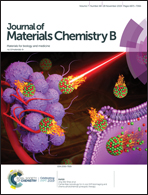A dual-responsive fluorescent sensor for Hg2+ and thiols based on N-doped silicon quantum dots and its application in cell imaging†
Abstract
In this study, a simple and rapid method was designed to synthesize N-doped silicon quantum dots (N-SiQDs) with a maximum excitation wavelength and maximum emission wavelength of 347 nm and 440 nm, respectively. The prepared N-SiQDs are colorless in aqueous solution with excellent dispersibility, and the fluorescence quantum yield is 28.8%. The fluorescence intensity of the N-SiQDs decreases rapidly within 30 s in response to Hg2+ to form the Hg2+–N-SiQD system. Under physiological conditions, glutathione can coordinate with Hg2+ in the Hg2+–N-SiQD system causing Hg2+ to detach from the surface of N-SiQDs, and the fluorescence of N-SiQDs is restored within 1 min. After optimization of the N-SiQD preparation conditions and the response conditions, the linear ranges for Hg2+ and glutathione detection are 0.1–4 μM and 0.1–5 μM with the detection limits of 24 nM and 55 nM, respectively. Besides, fluorescence imaging results indicate that the “on–off–on” Hg2+–N-SiQD fluorescent sensor can be successfully applied to the detection of biothiols in living cells.



 Please wait while we load your content...
Please wait while we load your content...